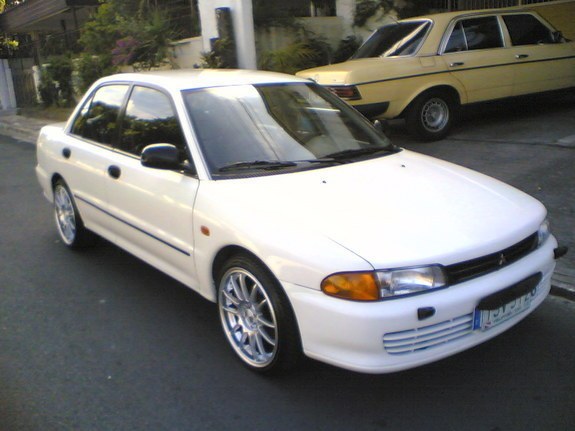1995 Mitsubishi Lancer GLXI upgrades?
 Question: I have a 1995 Mitsubishi Lancer GLXI, fuel injected,what are the things I can do to improve its performance? things I can change and upgrade.. thank you for your time
Question: I have a 1995 Mitsubishi Lancer GLXI, fuel injected,what are the things I can do to improve its performance? things I can change and upgrade.. thank you for your time
Answer:
Not sure if you have the turbocharged version or not but will start out with suggested upgrades for both versions and then touch on the turbo only upgrades…
General upgrades on turbo/non-turbo engine.
1. Intake and exhaust. The basic upgraded which get your engine breathing (intake) and exhaling (exhaust) better. For intake, typically a cold-air kit, which allows the engine to pull from cooler outside air, as opposed to hotter under-hood air is best. Exhaust is usually personal preference, no need to go for exotic materials like titanium but stainless steel will provide longer life. Sound level is a preference, not always an indication of how well the exhaust performs. With all of the suggestions I give, I would check online forums for other owners suggestions. You can sometimes find good advice, group discounts on parts, or even used parts at a good savings.
2. Computer – Most car companies tune their engines for long life and err on the safe side when it comes to timing, fuel curves etc. There may be a chip or add-on tuner which you can add to give your car more performance.
3. Cam shafts – Not sure of your specific engine, but this would be my last recommendation however could be pricey. The camshaft tells the valves when to open and close, by telling the valve to open sooner, or longer you can get more fuel and air in to the engine, this will allow you to make more power. Not the easiest job to replace the camshafts, or the cheapest, so it’s probably the last step.
Now on to the turbo engine (if you have it)
1. I would look at increasing the boost with a boost controller. Most Japanese cars can be adjusted with a manual boost controller or electronic controller without having to mess with the ECU (Engine computer). This can be dangerous turning up the boost too much with the resulting pre-detonation being capable of melting pistons. It’s also possible to turn the boost pressure up too much and out running your fuel injectors. To keep the proper fuel mixture your fuel injectors will have to work extra hard to keep up with the extra air going in to the engine. It’s possible you will need to upgrade the injectors depending on how much boost you want to run.
2. Intercooler: Compressing air in the turbo produces heat, hot air makes less power in your engine since it’s less dense than cool air. A better intercooler will cool down the air after the turbo and allow for more power.
Good luck and let me know if you have any other questions,
Posted: 27th July 2016 | Author: Kevin Schappell | Category: Engine, Exhaust
Camaro Rear End Noises
Question:
Hey I drive a used 2000 Chevy Camaro which I purchased a few days ago. It drives very well other than 2 problems. The first is a humming noise that comes from the rear of the car when I am parked. If I rev the engine up, somtimes it goes away.
The other question is about a very very subtle bumping noise when I am breaking from the rear. It is so subtle that it could be the breaks rubbing,but sometimes it does it when i am slowing down without breaking. I know both of these may seem small, but as a new owner of this used vehicle every little thing sticks out to me.
Can you help me??
Thanks,
Wally
Answer:
Wally,
Sounds like something loose in the exhaust system, probably causing
both issues you are having. The exhaust system is hung from the
chassis with rubber bushings providing for a little bit of movement,
and noise reduction. These rubber pieces wear out over time and need
to be replaced. You can take it to an exhaust shop and let them look
at it, or simply turn up the tunes a little and forget about it ! If
it were me, I would use the problem as an excuse to the wife to get a
new performance exhaust system.
Posted: 8th July 2009 | Author: Kevin Schappell | Category: Exhaust
Clogged Catalytic Converter?
Question:
Kevin,
I own a 2003 Chevy Monte Carlo SS. It has 130,000 miles on it. It appears to lose power when trying to accelerate when the engine is warm. For example, cruising on the interstate at 70 mph for a short time, engine at normal operating temperature, when I need to accelerate to pass the transmission down shifts, rpm increase, yet speed does not. I think my catalytic converter is becoming plugged. It does not seem to effect acceleration when the engine is cold. Any suggestions?
Thanks,
Bernie
Answer:
Sounds like the catalytic converter to me too. If this happens at night, pull off the road to a safe stop and pop the hood. Look at the catalytic converter and see if it’s glowing red. You may have to look under the car, and not under the hood to see it. I had an 86 Corvette that had the same problem and the headers and pipes before the converter would glow red due to the blockage. A technician can diagnose this problem too with a pressure check of the exhaust system before the converter. It will show high pressure before the converter if it’s clogged.
A bad O2 sensor could be to blame, but you should be getting a check engine light too. Also a clogged fuel filter may be causing a lean condition at the high speeds you are talking about. I would have it changed if it has not been as well as crawling under the car to look for the red hot converter.
Good Luck,
Kevin
Posted: 26th June 2006 | Author: Kevin Schappell | Category: Exhaust
The Basics of Performance Upgrades
It’s every guys dream to have his car, truck or SUV go faster than the next. The problem is, there are no real good roadmaps for every car, and a lot of money can be wasted chasing a few extra horsepower.
Let’s look at a few common upgrades that can gain you some horsepower and earn you some respect on the road. The first upgrade that can make the most difference and make your car sound awesome is the exhaust system. Many aftermarket manufacturers are producing bolt-on exhaust systems, which can help free up 5 – 20 HP depending on how restrictive your factory exhaust is. Most systems replace the pipes and mufflers from the catalytic converter back. These are commonly called Cat-Back Systems and can be had for a price of $250 – $750 depending on materials used. Stainless steel pipes will cost you more, but will last a lot longer than plain steel. If you plan on keeping your car more than 50,000 miles or live in a state that uses salt on the roads during the winter, I would suggest stainless steel. I personally like the sound of Flowmaster Mufflers as well as Borla… your taste may vary.
The next most common way to free up some horsepower is a performance air filter. By helping your engine breath better, the air filter will help you get more air and fuel into the cylinder and thus make more power. Be aware that most aftermarket filters will require some kind of cleaning and maintenance to work properly. K&N is my favorite brand and has been around the scene for a long time.
Related to the air cleaner, a cold air intake relocates the air filter so your engine is breathing cool outside air instead of hot under hood air. Not all cars can benefit from this modification, as it’s sometimes hard to get the air filter in a position to scoop up that cooler outside air. Check at your local parts store to see if they have a cold air intake for your specific vehicle.
Your car came from the factory built for long life and easy maintenance. The engineers at the factory have programmed your engine computer to err on the safe side at the sacrifice of more power. Aftermarket companies now produce computer chips, which will alter your engine computer and help it run at peak efficiency. For a little more than $150 you can pick up 10 – 30 HP by just changing your engine computer chip. Not bad for about an hours worth of work.
The old saying, nothing beats cubic inches is still true today, but unfortunately the new cars available today no longer come with 426 Hemi engines under the hood. Most of today’s cars do not have the room for bigger engines, so what is a car guy to do? Turbo charging or super charging is the answer for today’s cubic inch challenged engines.
Normally aspirated engines use outside air to fill the combustion chamber. To maintain the proper air/fuel ratio to support combustion, the engine can only burn so much fuel dictated by the size of the cylinders. This is why a larger displacement engine can produce more power, since the cylinders are larger, they can burn more fuel. In a turbo or super charged engine, the air coming into the cylinder is compressed and thus contains more oxygen, therefore requiring more fuel to completely burn. This gives you an increase in power, without adding more size to the cylinders. If you can cram twice the air and fuel into the same cylinder, you have just doubled the displacement and power of your engine.
This is a very simple overview of how a turbo charger or supercharger works, and there are some downsides to both systems, but you can now see why this method of making horsepower is used commonly on today’s street machines. If you are interested in adding a turbo or super charger to your vehicle, check around and see what kits are readily available for your vehicle. Start at your local parts store, or on the Internet to do your research. It won’t come cheap, but you can add 50 – 150 HP in about a weekend’s time and have the fastest car on the block.
Posted: 13th June 2006 | Author: Kevin Schappell | Category: Engine, Exhaust
Exhaust system options…
When you need to replace your exhaust system due to rust or damage, consider an aftermarket exhaust. If you are concerned about price, often times an aftermarket exhaust can be cheaper than the factory system.
I was working on my father’s 1989 Chevrolet Pickup and needed to replace the muffler and tail pipe. The factory parts were well over $200, and a complete aftermarket exhaust was $180. I went with the aftermarket exhaust DynoMax and ended up with a better sounding exhaust tone and a few bucks in my pocket.
I generally buy my exhaust systems from http://www.summitracing.com They have good prices and quick shipping.
Kevin
Posted: 24th January 2006 | Author: Kevin Schappell | Category: Exhaust
